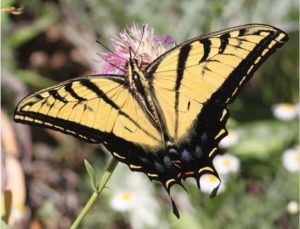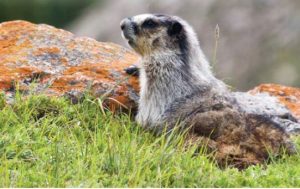

Citizens: Putting the “C” Into Conservation
September 1, 2019
- •
- •
- •
Wild Lands Advocate article by: Ian Urquhart, AWA Conservation Staff and Editor of Wild Lands Advocate
Click here for a pdf version of this article.
Many readers are likely familiar with the phrase “direct action.” The histories of the labour, suffragette, civil rights, and environmental movements are decorated with stories where people, frustrated with government’s failure to respect their interests and goals, directly confronted authorities to demand change. The thread joining all of these protest movements together was their decision to avoid traditional paths of political influence such as parliaments or bureaucracy. Instead, protests and strikes were the signatures of direct action.
The focus in this article, like in a discussion of direct action, is on conservation-oriented citizens who supplement or perhaps bypass altogether official methods of influence such as lobbying or voting. Instead, they are helping to build the scientific basis for conservation action by gathering data. They are, in a real sense, “citizen scientists.” The number of projects in Alberta with citizen science components is impressive. Three of those projects – a very, very small sample of citizen science endeavours – are noted here. If you have a favourite citizen science project you would like us to bring to the attention of Advocate readers please drop me a line at iurquhart@abwild.ca.
Counting Raptors with the Rocky Mountain Eagle Research Foundation
In 2017 CBC described the Rocky Mountain Eagle Research Foundation’s spring and fall raptor counts as “one of the largest and longest-running citizen science projects in the world.” The Foundation (see the eaglewatch.ca website) was the brainchild of Peter Sherrington. Peter was inspired to create this non-profit by an anomaly. Why, he wondered back in March 1992, did he see so many golden eagles flying northwest past Mount Lorette in Kananaskis Country. After counting just over 100 eagles on that day, Peter counted hundreds more over the next few days. By chance, Peter had discovered a golden eagle migration route. He had discovered the flyway that golden eagles use as they migrate in the spring and fall between as far away as Alaska/the Yukon to central Mexico.
Mount Royal University’s Sarah Hewitt noted in a 2018 Canadian Geographic article that, since 1992, the Foundation’s “thousands of volunteer scientists have logged more than 30,000 hours in the field, and recorded sightings of more than 24,000 golden eagles.” In that article Peter likened the ridges of the front range of the Rockies to “long, elevated prairie roads.” The eagles and other raptors use thermals – upward currents of warm air – to soar above the front range and conserve their energy during their migrations.
The Foundation’s website contains a very comprehensive database about golden eagle and other raptor sightings. The 2018 final report on the fall migration, as one example, offers the reader a wealth of information. Volunteers now collect data at three locations: Mount Lorette, Vicki Ridge near the east end of Crowsnest Pass, and the Steeples site near Cranbrook B.C. (the Steeples site is along a second migration corridor that runs through the Rocky Mountain Trench). At 2,698 golden eagles, observers counted 21.3 percent fewer birds than the long-term average in the fall 2018 count at Mount Lorette. This total was produced by an astounding 532.7 hours of observations from the 21 principal observers and assistants who attended the site between September 20th and November 15th. This decline unfortunately reflects the general trend recorded at the Mount Lorette site since 2003. To my eyes, perhaps the most positive data from the 2018 report concerned the immature:adult golden eagle ratio. At 0.42 this ratio was 40 percent above average; it was the third highest ratio every recorded there. Like the ratio of juvenile birds to subadults and adults, this immature/adult ratio indicated that the 2018 breeding season was very productive.
When you read this article the fall 2019 count will be underway (it runs from September 20th to November 15th). Visitors are welcome at the Foundation’s Hay Meadow observation station. More details can be found at the eaglewatch.ca website. Since October is the busiest month of the fall migration we have a wonderful opportunity to become more familiar with the valuable work of these citizen scientists.

Two-tailed swallowtail (Papiliio multicaudata)
PHOTO: © ALAN SCHMIERER (courtesy of Wikimedia Commons)
Waterton’s Annual Butterfly Count
The butterfly is one of our smaller, but most beautiful, barometers of ecosystem health. For 20 years now, a butterfly count has been a fixture of summertime activities in Waterton Lakes National Park. Kim Pearson, an ecosystem scientist with the Waterton/Bar-U Ranch Field Unit of Parks Canada, co-founded the count while she was a student working with Parks Canada in 1999. Every year since volunteers, butterfly nets in hand, head out into various areas of the park looking for butterflies. Parks Canada staff teach the volunteers to use the “swish and flick” technique to capture the butterflies; any butterflies caught by the volunteers are brought to the group leader for identification.
As Pearson told Doug Dirks, host of CBC’s The Homestretch: “We take them out of the nets very gently, are very careful with them, identify them and then we release them back into the Park so we don’t have any impact on their populations.”
Between 1999 and 2018, nearly 1,500 butterflies representing 105 species had been caught and released during Waterton’s annual counts. The number of species caught each year has ranged between 12 and 52. As noted above, butterflies are one barometer of ecosystem health. This is reflected in facts such as their importance as pollinators and their sensitivity to pesticides. According to Pearson, “butterflies are doing really well in Waterton…(there is) a lot of diversity here.” The 2017 Kenow wildfire doesn’t appear to have damaged butterfly diversity health in the park. In 2018, the count recorded at least an average number of butterflies. Last year stood out for the appearance of the two-tailed swallowtail butterfly (Papilio multicaudata) in the count. Although two-tailed swallowtails had been seen before, 2018 was the first year one was caught and released during the count.
After the 2019 count Pearson intended to use the database established over the past 20 years to construct a synopsis of the counts. Here she hopes to work with scientists who have an expertise in Alberta’s butterflies. How much credence should we give to such a synopsis? Likely quite a bit according to an article by Soroye, Ahmed, and Kerr published in 2018. They examined the contribution opportunistic citizen science could make to better understanding the richness, distributions, and phenologies of butterflies. They compared the data obtained from an opportunistic citizen science program with data from professional surveys. The eButterfly program, launched in 2011, allows butterfly enthusiasts to build a database of butterfly sightings that may be shared with anyone. Its originators hope that this growing database “will become the foundation for a better understanding of butterfly distribution and population trends across North American and beyond.” The Soroye/Ahmed/Kerr comparative study found real value in this example of opportunistic citizen science. They wrote: “Our results suggest that data from opportunistic CS programs in conjunction with professional datasets can strongly increase the capacity of researchers to estimate species richness, and provide unique information on species distributions and phenologies that are relevant to the detection of the biological consequences of global change.”
Bow Valley Naturalists’ High Elevation Localized Species Project
Since 2010 the Bow Valley Naturalists (BVN) has included a webpage people may use to record sightings of four High Elevation Localized Species (HELS): hoary marmot, mountain goat, pika, and white-tailed ptarmigan. The HELS project exemplifies opportunistic citizen science; this type of program invites participants/volunteers to report their observations of these four species from anywhere at any time. Currently, more than 250 people are registered on the HELS website. You can use one of two methods to record a sighting. You can click
the location on a map or you can input UTM (Universal Transverse Mercator) coordinates. Since it’s vital for locations to be reported accurately the BVN recommends you use points fixed by GPS units. What I plan to do is use my GPS app to record the latitude/longitude of a sighting and then convert those coordinates to UTM ones when I get back home (I find the Latitude/Longitude to UTM converter at https://www.latlong.net/lat-long-utm.html easy to use).
The BVN started this project to provide essential baseline information about these species. As anyone who has done policy research will attest to, this vital data too often hasn’t been gathered and the knowledge baselines needed to formulate good policy then are shrouded in uncertainty. If this project improves our knowledge of the distribution of these species the BVN hopes that knowledge “will set the stage for research directed at assessing human impacts by evaluating those features in the landscape that most influence gene flow and exchange of individuals between populations.” It also hopes the data will provide a starting point for evaluating the impact climate change may have on these species.
In its first ten years, the HELS project has recorded nearly 3,500 sightings of these high elevation species. The HELS database made a vital contribution to Christopher Shank’s research into the vulnerability of pikas to climate change. As average temperatures rise in the Canadian Rockies over the course of this century, pikas are going to have to migrate higher on mountain slopes in order to find the cooler temperatures
they need to survive.
Shank’s research concluded somewhat optimistically that, based on the US Fish and Wildlife Service’s temperature criterion for pika persistence and two climate emissions scenarios, none of Alberta’s pika populations are likely to be threatened by increasing mean summer temperatures for most of this century. However, the study was limited to considering only the impact of emissions on mean temperatures. As Shank noted, his study didn’t consider the impact climate change may have on the quality of the habitat pika need to survive.
Conclusion
These are just three examples of citizens getting directly involved in conservation. They exemplify how through our individual actions we can help generate the knowledge and will to better conserve the natural world.

